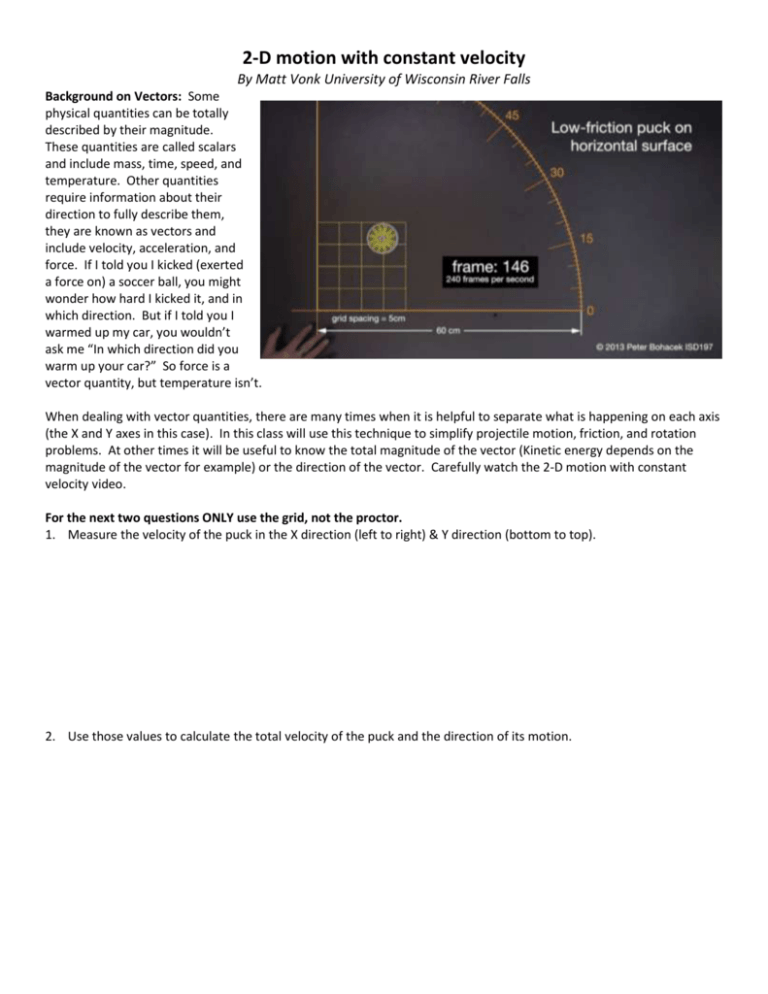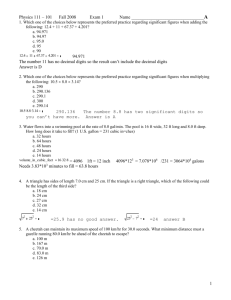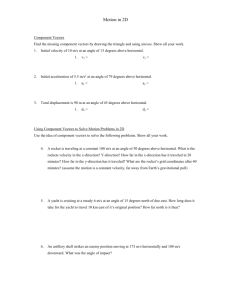2-D motion with constant velocity
advertisement

2-D motion with constant velocity By Matt Vonk University of Wisconsin River Falls Background on Vectors: Some physical quantities can be totally described by their magnitude. These quantities are called scalars and include mass, time, speed, and temperature. Other quantities require information about their direction to fully describe them, they are known as vectors and include velocity, acceleration, and force. If I told you I kicked (exerted a force on) a soccer ball, you might wonder how hard I kicked it, and in which direction. But if I told you I warmed up my car, you wouldn’t ask me “In which direction did you warm up your car?” So force is a vector quantity, but temperature isn’t. When dealing with vector quantities, there are many times when it is helpful to separate what is happening on each axis (the X and Y axes in this case). In this class will use this technique to simplify projectile motion, friction, and rotation problems. At other times it will be useful to know the total magnitude of the vector (Kinetic energy depends on the magnitude of the vector for example) or the direction of the vector. Carefully watch the 2-D motion with constant velocity video. For the next two questions ONLY use the grid, not the proctor. 1. Measure the velocity of the puck in the X direction (left to right) & Y direction (bottom to top). 2. Use those values to calculate the total velocity of the puck and the direction of its motion. For the next two questions ONLY use the protractor, not the grid. 3. Measure of total velocity of the puck and the angle of its motion. 4. Use these values to calculate the components of the velocity in the X & Y directions. Also use these values to calculate the x and y displacements of the puck after whatever time interval you used in question 3. 5. We can use these values to picture two triangles that represent velocity and displacement. For each triangle below write in the values that you found using the grid. x=_______ = __ y=_______ vy= ________ = __ vx=_______ NOTE: In some cases (like this one) the angle is the same on both triangles. However when the motion isn’t in a straight line, then the angle of the velocity may not correspond to the angle of the total displacement. Other than the angle (which may or may not be the same) you must NEVER mix the values between the triangles. At some point in the semester I always have a student that puts a displacement on one leg of the triangle and a velocity on another and then tries to calculate the length of the third side using trigonometry. That is always wrong. 6. Use the velocity and angle values from the protractor above to calculate the x and y displacements of the puck after whatever time interval(s) you used in question 1. Because of the uncertainties in your measurements it would be unlikely for the values you got using the protractor to exactly agree with the values you got using the grid. However, on this video the uncertainties are relatively small and your answers should agree to within a few percent. 7. For each of the six values above (velocityx, velocityy, velocitytotal, & angle of motion, x & y displacements) calculate the percent difference between the value found with the grid and the value from the protractor. Note: percent difference = difference/averagex100% = (value1–value2)/((value1+value2)/2)x100%






